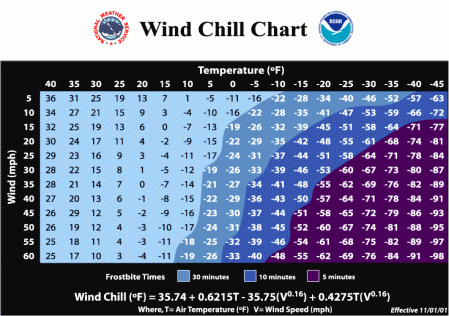 Winter is officially here, whipping in at 6:04 a.m., and while today may be cold, tomorrow (December 22) will be brutally cold.
Winter is officially here, whipping in at 6:04 a.m., and while today may be cold, tomorrow (December 22) will be brutally cold.
According to the National Weather Service, which issued a special weather statement this morning, a cold arctic air mass is about to sweep into the mid-state region bringing with it the coldest temperatures in six years by Monday morning. That statement includes a forecast for dangerous wind chill levels. While northern folks are used to such frigid weather and ready for it, Tennesseans are going to have bundle up in a way that they are not used to.
A predicted northwest wind gusting to near 30 mph this afternoon and temperatures will be hard-pressed to hit the 30 degree mark. Wind child readings (the “feels like” temperature) will dip into the teens, falling into single digits across much of the region. Wind chill readings could hit -5 — yes, five below zero. A wind chill advisory could be issued later today.
 That means extra protection is needed to stay healthy, especially if you have to be outdoors. When exposed to cold temperatures, your body begins to lose heat faster than it can be produced. Prolonged exposure to cold will eventually use up your body’s stored energy. The result is hypothermia, or abnormally low body temperature. Body temperature that is too low affects the brain, making the victim unable to think clearly or move well. This makes hypothermia particularly dangerous because a person may not know it is happening and won’t be able to do anything about it.
That means extra protection is needed to stay healthy, especially if you have to be outdoors. When exposed to cold temperatures, your body begins to lose heat faster than it can be produced. Prolonged exposure to cold will eventually use up your body’s stored energy. The result is hypothermia, or abnormally low body temperature. Body temperature that is too low affects the brain, making the victim unable to think clearly or move well. This makes hypothermia particularly dangerous because a person may not know it is happening and won’t be able to do anything about it.
Hypothermia is most likely at very cold temperatures, but it can occur even at cool temperatures (above 40°F) if a person becomes chilled from rain, sweat, or submersion in cold water.
Pay attention your neighbors; the elderly, who often live alone, are particularly subject to hypothermia. Pay attention to your pets too; bring them inside or ensure that they have adequate shelter and that the doghouse door is facing away from the wind.
Victims of hypothermia are often (1) elderly people with inadequate food, clothing, or heating; (2) babies sleeping in cold bedrooms; (3) people who remain outdoors for long periods—the homeless, hikers, hunters, etc.; and (4) people who drink alcohol or use illicit drugs.
If you notice any of these signs, take the person’s temperature. If it is below 95°, the situation is an emergency—get medical attention immediately.
If medical care is not available, begin warming the person, as follows:
 Get the victim into a warm room or shelter.
Get the victim into a warm room or shelter.- If the victim has on any wet clothing, remove it.
- Warm the center of the body first—chest, neck, head, and groin—using an electric blanket, if available. Or use skin-to-skin contact under loose, dry layers of blankets, clothing, towels, or sheets.
- Warm beverages can help increase the body temperature, but do not give alcoholic beverages. Do not try to give beverages to an unconscious person.
- After body temperature has increased, keep the person dry and wrapped in a warm blanket, including the head and neck.
- Get medical attention as soon as possible.
A person with severe hypothermia may be unconscious and may not seem to have a pulse or to be breathing. In this case, handle the victim gently, and get emergency assistance immediately. Even if the victim appears dead, CPR should be provided. CPR should continue while the victim is being warmed, until the victim responds or medical aid becomes available. In some cases, hypothermia victims who appear to be dead can be successfully resuscitated.
If you must be outdoors for any period of time, dress warmly and in layers. Use a parka or windproof jackets — they are called “windbreakers” because that’s these jackets do). wear gloves or mittens, and a hat (we lose much of our body heat through our heads. Wear warm socks and boots with thick soles that put a layer of insulation between your feet and the ground.
Single digit cold has not been recorded in Nashville since January, 2003.
Some information for this article obtained from the National Weather Service and the CDC (Center for Disease Control).

